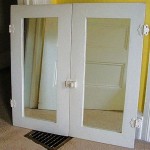Are Car Mirrors Concave or Convex?
Car mirrors, crucial for driver safety and spatial awareness, utilize specific mirror types to enhance visibility. Understanding the difference between concave and convex mirrors is essential to grasping how car mirrors function and why they are designed the way they are. This article explores the curvature of car mirrors, explaining the principles behind their design and the benefits each type offers.
Passenger-Side Mirror: Convex
Passenger-side mirrors are universally convex. A convex mirror curves outward, creating a wider field of view than a flat mirror of the same size. This wider field of view allows the driver to see more of the lane beside the car and reduce blind spots. However, this wider view comes at the cost of image distortion. Objects appear smaller and further away than they actually are. This distortion is why passenger-side mirrors often carry the warning "Objects in mirror are closer than they appear."
Driver-Side Mirror: Varies by Region
The type of mirror used on the driver's side varies depending on the region and local regulations. In some regions, like North America, plane (flat) mirrors are standard. Plane mirrors reflect light without distorting the image's size or shape, providing a true representation of the distance and size of objects. However, plane mirrors offer a more limited field of view compared to convex mirrors.
In other regions, like Europe and Asia, driver-side mirrors are commonly convex, similar to the passenger-side mirror. The rationale behind using a convex mirror on the driver's side is the same as for the passenger side: to maximize the field of view and reduce blind spots. While the distortion affects distance perception, drivers adapt to this distortion through experience and visual cues from other sources.
Rearview Mirror: Plane
The rearview mirror, positioned inside the vehicle, is typically a plane mirror. Its purpose is to provide a clear and undistorted view of the traffic directly behind the vehicle. The flat surface ensures accurate size and distance perception, allowing drivers to judge distances and speeds of vehicles approaching from the rear. While a wider field of view might be beneficial, minimizing distortion and providing accurate spatial information is prioritized for the rearview mirror.
The Physics of Convex Mirrors
Convex mirrors diverge reflected light rays. This divergence creates a virtual, upright, and diminished image. The virtual image appears to be located behind the mirror's surface. The diminished size of the image allows a wider field of view to be compressed onto the mirror’s surface. This widening effect is the key reason for the use of convex mirrors in passenger-side car mirrors.
The Physics of Plane Mirrors
Plane mirrors reflect light rays without diverging or converging them. This results in a virtual image that is the same size and distance from the mirror as the object being reflected. The image is also upright and laterally inverted (left and right are reversed). This accurate representation of size and distance is why plane mirrors are preferred for rearview mirrors where accurate spatial information is crucial.
Safety Implications and Blind Spots
While convex mirrors provide a wider field of view, the image distortion can lead to misjudgments of distances, especially for drivers unfamiliar with their use. This is why adjusting mirrors correctly and understanding the limitations of convex mirrors is essential for safe driving. Proper mirror adjustment can minimize blind spots, but drivers should always conduct head checks and be aware of the potential for hidden vehicles, especially when changing lanes.
Furthermore, the differences in driver-side mirror types across regions can present challenges for drivers traveling internationally. Drivers accustomed to a plane mirror on the driver's side might experience a period of adjustment when driving a vehicle with a convex driver-side mirror and vice-versa. Being aware of these regional differences and taking the time to adjust to the specific mirrors on a vehicle is vital for safe driving in unfamiliar environments.
Modern vehicles increasingly incorporate technologies to mitigate the limitations of traditional mirrors. Blind spot monitoring systems, lane change assist, and rearview cameras provide additional visual and auditory warnings to alert drivers to potential hazards. These technologies complement the information provided by mirrors and enhance overall driving safety.

Convex And Concave Mirrors In Cars

Convex Mirrors Use Car
Why Are Side View Mirrors Flat On The Driver But Convex Passenger Quora

Concave Vs Convex Mirrors In Cars
In Trucks Cars Buses Side View Mirrors Are Convex But Center Rear Mirror Is Or Plane Quora

Convex Concave Mirror Car Motorcycle Rear View Glass China Silver Made In Com

The Reason Why Objects In A Car S Side View Mirror Are Closer Than They Appear Mental Floss
Objects In The Mirror Are Actually Images Article Khan Academy

Concave Mirror At Rs 800 Piece Mirrors In Chennai Id 13051262512

What Are Safety Mirrors And Which Factors Should Be Considered Before One








